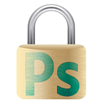In an earlier groovyPost, I touched on the basics of Layers in Adobe Photoshop however there is so much more to talk about I figured I would do a follow-up post reviewing some of the more advanced features. Understanding how Layers work and being able to manipulate them is a key foundation in using Photoshop so if you have any questions or comments, please drop them below in the comments.
Introduction to a Locked Layer
When importing images into Photoshop using File > Open, you may have noticed that if you import any regular JPG or JPEG file, you will end up with a single layer called Background and it will have a small lock on its side.
The lock simply means you can’t do any edits to the image and you will have to double-click and give your layer a name to unlock it.
Can I lock layers manually?
Yes, you can. If a layer is fully unlocked, you can give it four types of locks, all for a different purpose.
The first lock (starting from left to right) is the Lock transparent pixels lock. This lock prevents you from using tools like the eraser tool on that layer. The second lock is the Lock image pixels lock which prevents you from using tools like the brush tool or the pencil tool. The third lock is the Lock position. The lock position option will (obviously) block you from using the move tool to move your layer around. The last lock is the Lock all lock, or as I like to call it the Full lock – it locks your layer completely, not allowing any changes to be done to it.
What is a layer mask?
The Layer Mask simply put, “masks” your image and only shows the parts of the image you choose. It’s kind of like removing a background, only more useful since you can come back to your mask later and make more changes to it (kind of like in the case with adjustment layers).
What is the best way to make a layer mask?
Below I’ll show you the method I prefer for making a layer mask. There are other methods, but this one appeals to me the most. First select the area, object, or person in the image you’d like to keep using any selection tool you like. In previous Photoshop groovyPost tutorials I demonstrated how-to select images so try a search if you need a refresher or take a read of this article for a few options.
Now right click and pick Fill…
…and then just click the small Add layer mask button…
…your image background will be cleared…
…and your layer will look like this:
You can later return to your layer mask and edit it a bit if your not happy with the end result (as mentioned above) however I think you get the point. So there you have it! Your now an PRO in understanding and using Layers! Yeah I know, it’s never as simple as it looks so please be sure to practive a little then post your questions or comments here and we can discus! Comment Name * Email *
Δ Save my name and email and send me emails as new comments are made to this post.









